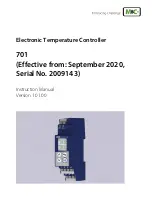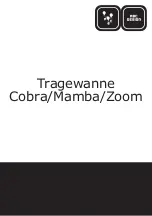
14
1. SECURITY RULES
PLEASE
NOTE:
IMPORTANT
SAFETY
INSTRUCTIONS.
C
AREFULLY OBSERVE ALL THE
FOLLOWING INSTALLATION INSTRUCTIONS TO ENSURE PERSONAL SAFETY
.
I
MPROPER
INSTALLATION CAN SERIOUSLY ENDANGER SAFETY
.
K
EEP THESE INSTRUCTIONS AFTER
INSTALLATION
.
MANDATORY RISK ANALYSIS AND PROTECTION MEASURES
.
The Nekos electrical actuators comply with the Machinery Directive (2006/42/EC), Standard IEC 60335-
2-103 (Particular requirements for drives for gates, doors and windows) and other directives and
regulations indicated in the attached Declarations of Incorporation and CE Conformity (at the end of the
manual). According to the Machinery Directive, actuators are “partly completed machinery” intended for
incorporation into doors and windows. The manufacturer/supplier of the window is required, with
exclusive responsibility, to ensure the compliance of the entire system with the applicable standards and
to issue CE certification. We strongly discourage any use of the actuators other than that specified and
therefore, in any case, the supplier of the complete system retains full liability.
For systems installed at a height of less than 2.5 m above floor level or other levels accessible to
users, the manufacturer/supplier of the window must conduct
risk analysis
regarding potential
harm (violent blows, crushing, wounds) caused to people by normal use or possible malfunction or
accidental breakage of the automated windows, and to implement suitable protective measures in
view of these. Such measures include those recommended by the specified standard:
- controlling the actuators via a “deadman’s button” placed near the system and within the
operator’s field of view, to ensure that people are out of the way during operation. The button
should be placed at a height of 1.5 m and operated by key if accessible to the public; or:
- use of contact safety systems (also included in the actuators) that ensure a maximum closing
force of 400/150/25 N, measured in accordance with paragraph BB.20.107.2 of IEC 60335-2-
103; or:
- use of non-contact safety systems (lasers, light grids); or:
- use of fixed safety barriers that prevent access to moving parts.
Automated windows are deemed adequately protected if they:
- are installed at a height of >2.5 m; or:
- have a leading-edge opening of <200 mm and a closing speed of <15 mm/s; or:
- are part of a smoke and heat evacuation system for emergency use only.
In any case, moving parts of windows that could fall below 2.5 m following breakage of a system
component need to be fixed or secured in order to prevent them from suddenly falling or
collapsing: e.g. the use of safety arms on bottom-hung windows.
The device is not intended for use by persons (including children) with reduced physical,
sensory or mental capabilities, or lacking experience and knowledge. Do not allow
children to play with the fixed controls and keep any remote-control units out of their
reach.
The actuator is destined exclusively for installation indoors. For any special application we
recommend you consult the manufacturer beforehand.
After removing packaging, check for any damage on the appliance.
MAINTENANCE and REPAIRS
Periodically check the installation by inspecting the cables, springs, rods and mechanical
parts for wear or damage. Do not use if repair or adjustment is required.
Disconnect the power supply during cleaning or maintenance operations.
Do not use solvents or jets of water to wash the appliance. The appliance should not be
submerged in water.
In the event of breakage or malfunction, switch the appliance off at the general switch and
call for the services of a qualified technician. Repairs should only be performed by
qualified personnel at assistance centres authorised by the manufacturer.
English
15
Always request exclusive use of original spare parts. Failure to respect this condition
could compromise safety and invalidate the benefits contained in the warranty for the
appliance.
In the event of any problems or queries, consult your agent or contact the manufacturer
directly.
2. FORMULAS AND RECOMMENDATIONS FOR INSTALLATION
2.1. Calculation of opening / closure force
Using the formulas on this page, approximate calculations can be made for the force required to
open or close the window considering all the factors that determine the calculation.
Symbols used for the calculation
F (Kg) = Force for opening or closing
P (Kg) =
Weight of the window (mobile sash only)
C (cm) = Opening stroke (actuator stroke)
H (cm) = Height of the mobile sash
For horizontal light domes or
skylights
F = 0.54 x P
(Eventual weight of snow or wind on the
cupola should be calculated separately)
.
For vertical windows
TOP HUNG WINDOWS
,
OUTWARD OPENING
(A)
BOTTOM HUNG WINDOWS
(B)
F = 0.54 x P x C : H
(Eventual load of favourable or unfavourable wind
on the sash should be calculated separately.)
2.2. Maximum opening according to height of sash
The actuator stroke is in accordance with the height of the sash and its application. Check that the
actuator stroke does not touch the profile of the sash and that the chain does not exert force on the
window frame (measurements in mm).
A
TTENTION
.
For safety reasons the actuator should not be assembled if dimensions are
inferior to those indicated in the table below. In the event that the height of the sash should
be lower, call on the manufacturer to check the appliance.
Mode of installation
Selection of actuator stroke
240
360
Light domes, skylights or vertical top hung windows opening
outwards with frontal assembly
400
550
Top hung windows opening outwards with horizontal assembly
400
550
Bottom hung windows
(motor on frame)
400
550
Bottom hung windows
(motor on sash)
Consult manufacturer

























